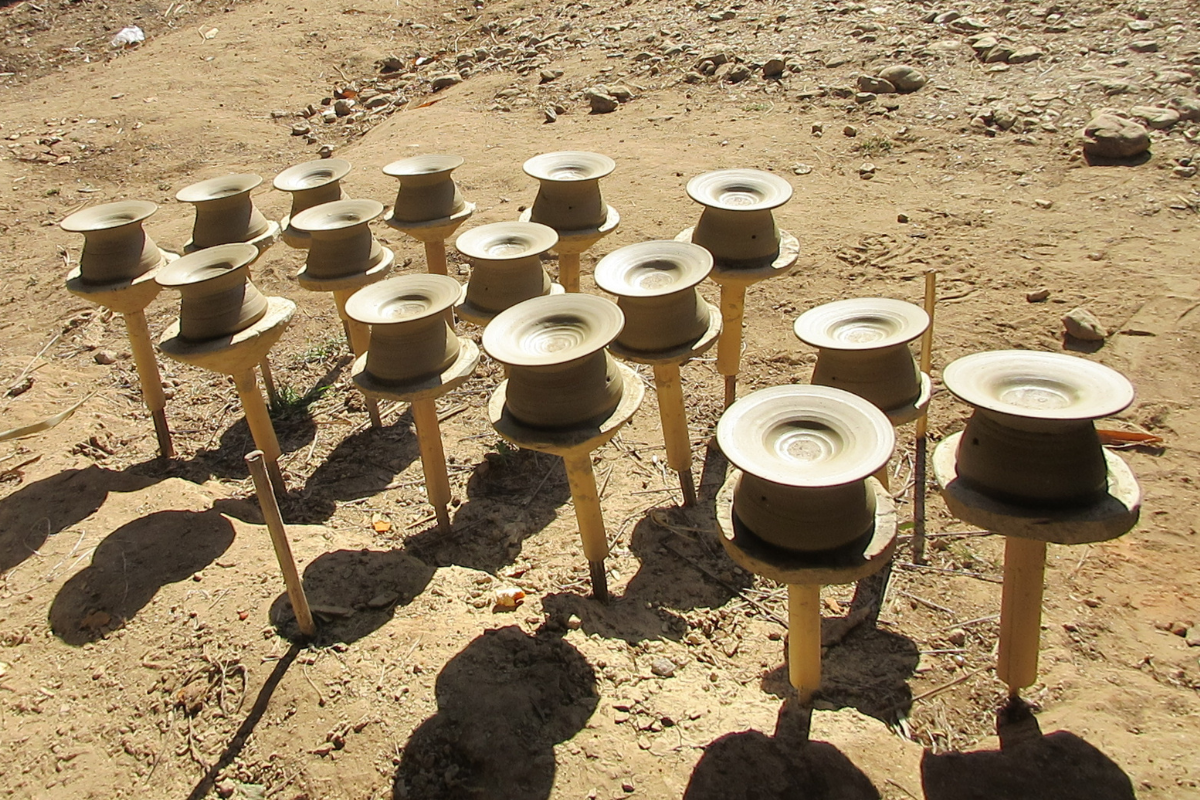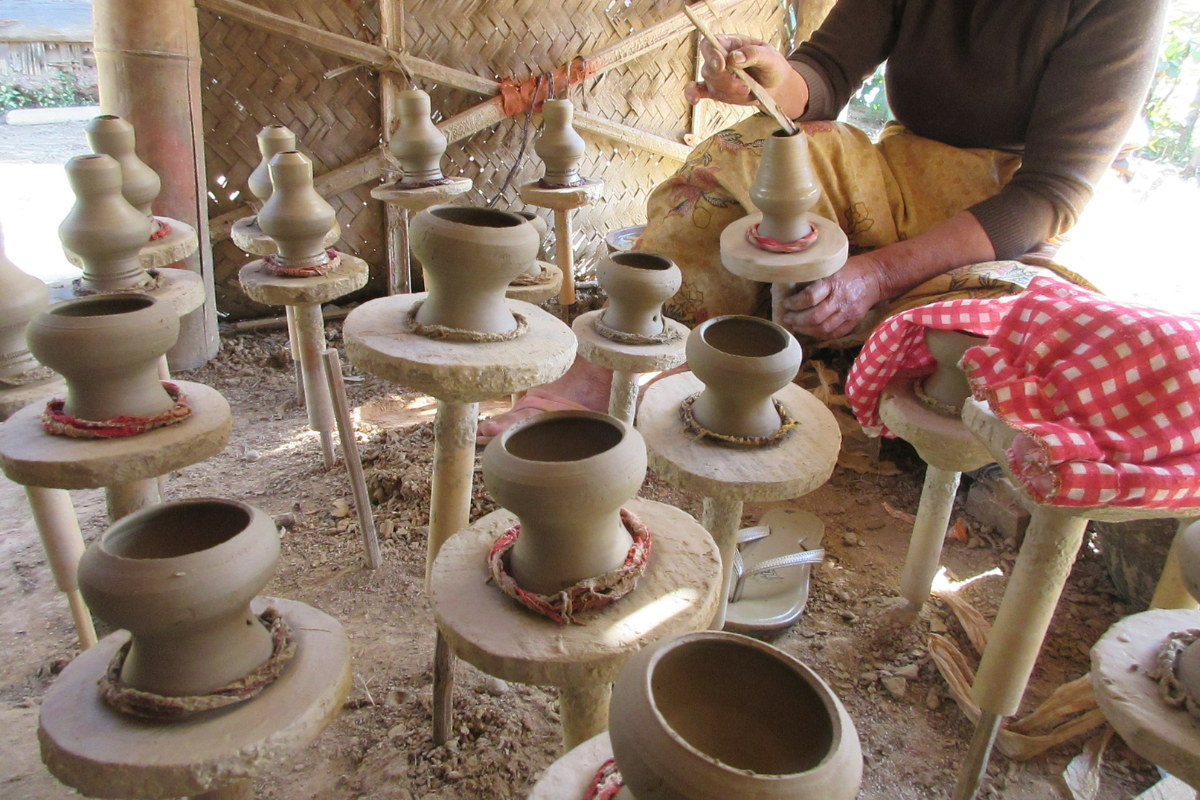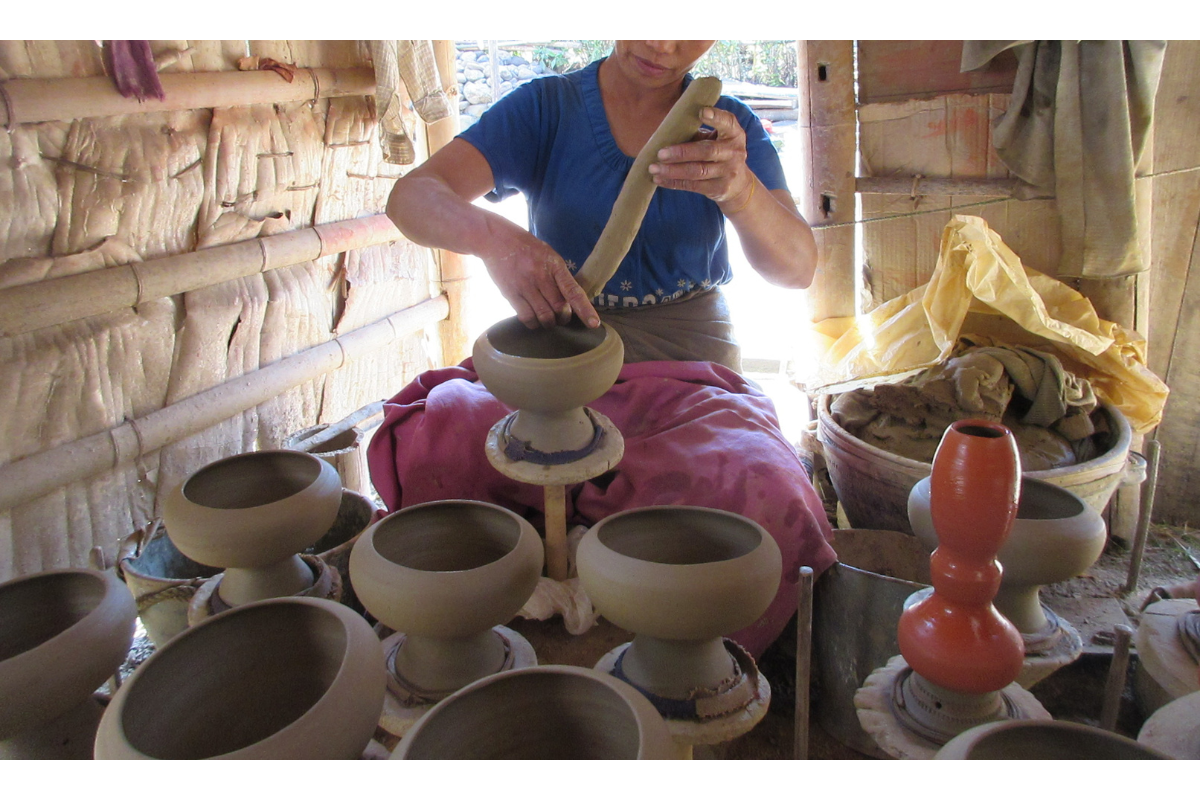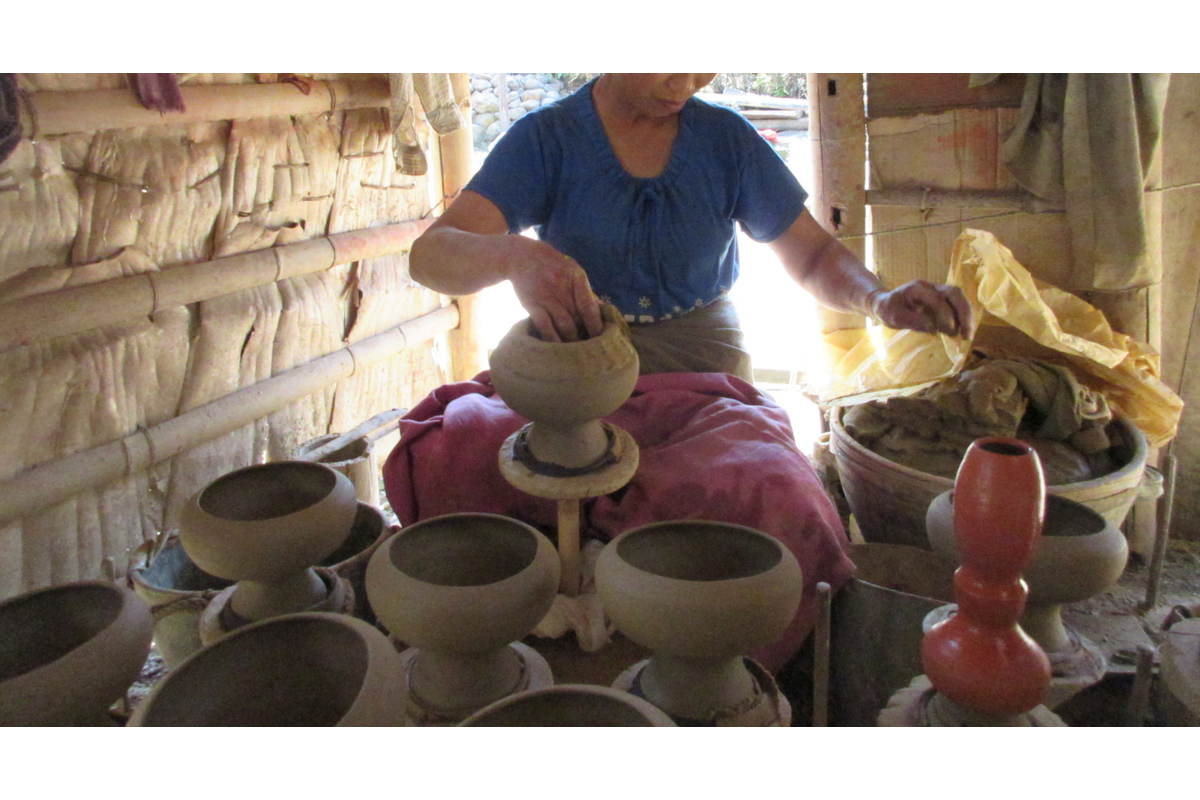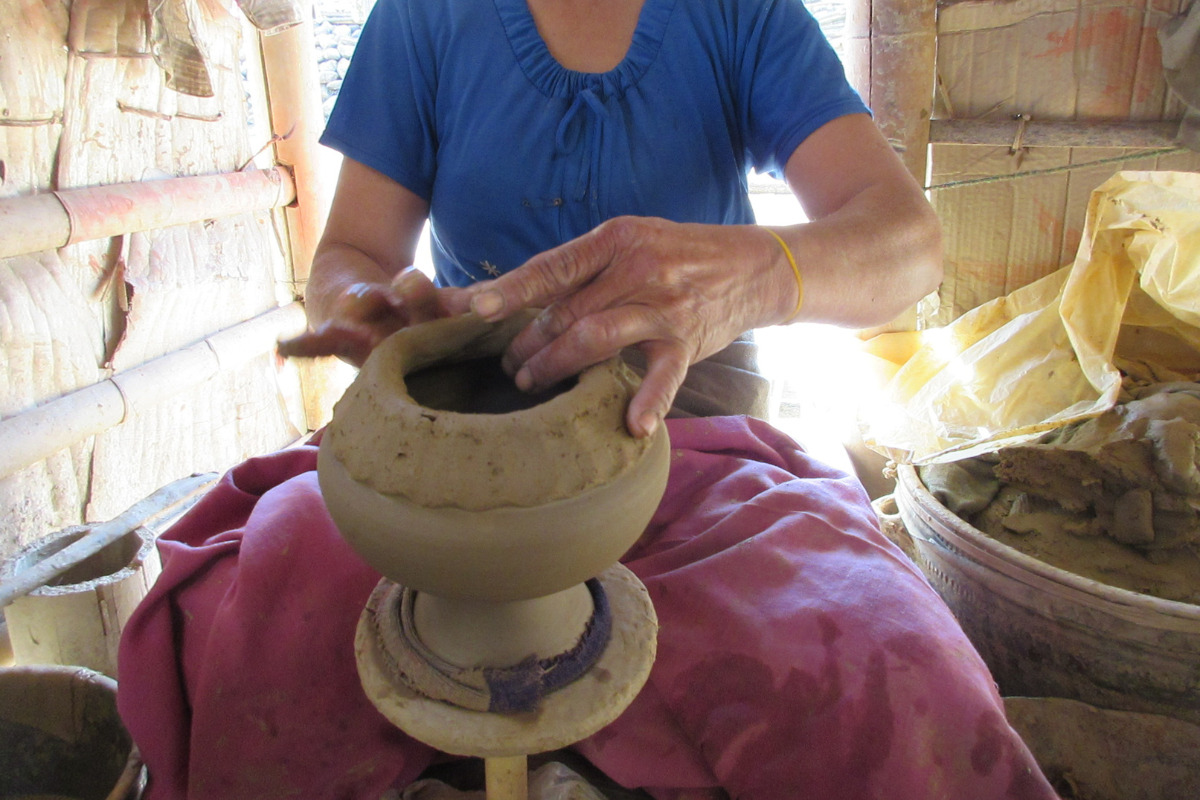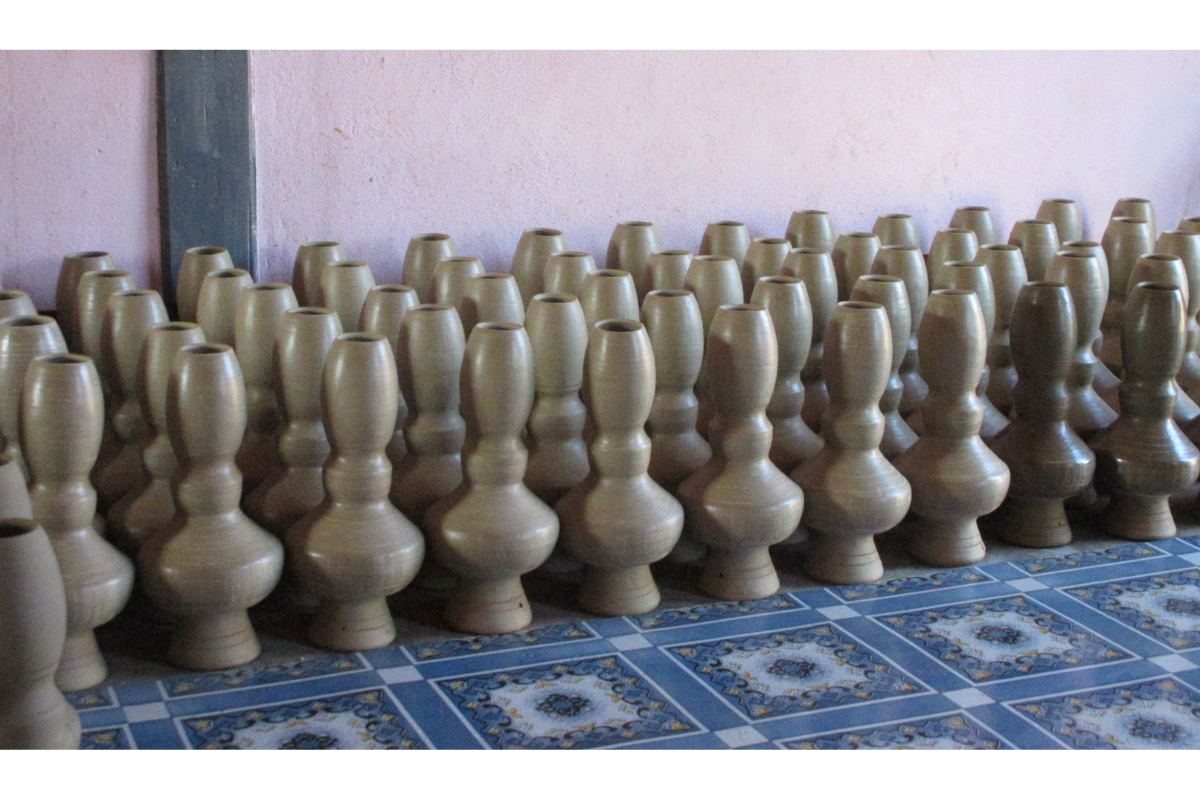Libation Jar Pottery at Kon Kan Village
| Myanmar Name: | ကုန်းကန်ရွာ ရေတကောင်းအိုးလုပ်ငန်း |
| Other Name: | |
| Type of Asset: | Handcrafts [လက်မှုလုပ်ငန်းများ] |
| Location: | Kon Kan Village, Mong Kung Township, Southern Shan State. [ကုန်းကန်ရွာ၊ မိုင်းကိုင်မြို့နယ်၊ ရှမ်းပြည်နယ်တောင်ပိုင်း] |
Asset Description
-
Kon Kan Village, a small community predominantly inhabited by the Shan ethnic group, is located just two miles south of Mong Kung. This village is particularly renowned for its distinctive pottery, which exclusively features the libation jar or “yay ta-kawng-o.” The craft is a central part of almost every family's life in the village, with women specializing in the hands-on pottery work and men responsible for gathering raw materials. This work is typically undertaken during the cold, dry season when agricultural activities are on hold. The finished water jars are then sold and distributed throughout Eastern and Northern Shan State.
The pottery of Kon Kan stands out due to its unique methods. Jars are individually constructed on various stands, without the use of a potter's wheel. To protect their creations from the elements, potters erect temporary low roofs beside their homes. These jars are valued not only for their artistic quality but also for their cultural significance. Red jars are believed to keep water cool, while black jars are thought to be stronger.
A significant cultural practice among the villagers involves making an offering to a goddess named Hway Nang Hisakha before digging for clay. During this ritual, they sing songs and present a tray of candles, incense, and flowers, honoring their commitment to the spirit. They believe that if a mistake is made or the goddess is displeased, they won’t find the red clay. This practice underscores the community's deep-rooted cultural beliefs concerning nature and the power of spirits.
Today, the Kon Kan village pottery industry remains a vital source of income for both local men and women, serving as a living testament to their enduring traditional culture.
The process of making the libation jar involves several meticulous steps:
Clay Preparation: Clay is first dug up, steeped in water for a day, and then thoroughly pounded before being molded by hand.
Sequential Shaping: The jar is constructed in four distinct stages: the base, body, neck, and rim. After each stage, it undergoes partial sun-drying before the subsequent step.
Finishing Touches: Once fully formed, the jar is coated with a powder derived from red clay that has been soaked for a month. This is followed by polishing with a small stone.
Kiln Firing: The completed jars are fired in a kiln. Pine bark is used to produce red pots, while bamboo firewood creates black pots. The pots are carefully stacked on top of one another during the firing process.
-
မိုင်းကိုင်မြို့မှ တောင်ဘက်သို့ နှစ်မိုင်ခန့်အကွာရှိ ကုန်းကန်ရွာသည် ရှမ်းတိုင်းရင်းသားများ နေထိုင်သည့် ကျေးရွာလေးတစ်ရွာဖြစ်ပြီး၊ အထူးသဖြင့် ရေတကောင်းအိုးလုပ်ငန်းကြောင့် ထင်ရှားသည်။ ယင်းရွာတွင် ရေတကောင်းအိုးတစ်မျိုးတည်းကိုသာ ထုတ်လုပ်ကြပြီး အိမ်တိုင်းလိုလို အိုးလုပ်ငန်းကို လုပ်ကိုင်ကြသည်။ အမျိုးသမီးများသည် အိုးလုပ်ခြင်းနှင့် ပတ်သက်သည့် လက်မှုများကို လက်ခံဆောင်ရွက်ပြီး၊ အမျိုးသားများကတော့ ကုန်ကြမ်းများ ရှာဖွေစုဆောင်းပေးကြသည်။ ထိုလုပ်ငန်းသည် စိုက်ပျိုးရေး အလုပ်ရပ်နားသည့် ဆောင်းရာသီအတွင်းသာ လုပ်ကိုင်ကြခြင်းဖြစ်ပြီး၊ ထုတ်လုပ်သည့် ရေတကောင်းအိုးများကို ရှမ်းပြည်အရှေ့ပိုင်းနှင့် မြောက်ပိုင်းများသို့ တင်ပို့ရောင်းချလေ့ရှိသည်။
ရေတကောင်းအိုးများကို အိုးထိန်းစက် (သို့) လက်လှည့်ခုံ အသုံးမပြုဘဲ တင်ခုံအသီးသီးပေါ်တွင် တစ်လုံးချင်း တည်ဆောက်ရခြင်း၊ မိုးလေထိခိုက်မှု မရှိစေရန် အိမ်ဘေးဘက်တွင် အမိုးနိမ့်တစ်ခု ခေတ္တတည်ဆောက်၍ အလုပ်လုပ်ကြခြင်း စသည်တို့မှာ ထူးခြားသည့် လုပ်ထုံးလုပ်နည်းများဖြစ်သည်။ ထိုအိုးများသည် အနုပညာအရည်အသွေးမြင့်သည့် လက်ရာအိုးများ ဖြစ်သည့်အပြင် အနီရောင်အိုးကို အေးမြစေသည်ဟု ယုံကြည်ကြပြီး အမဲရောင်အိုးကို ပိုမိုခိုင်မာစေသည်ဟု ယူဆကြသည်။
ယဉ်ကျေးမှုဆိုင်ရာအရ ကုန်းကန်ရွာသူများသည် ရေတကောင်းအိုးလုပ်ရန် မြေထွက်ရာ၌ နတ်သမီး ဟွေနန်းဟိစာခအား ပူဇော်ရသည့် ယုံကြည်မှုရှိကြပြီး ဖယောင်းတိုင်၊ အမွှေးတိုင်၊ ပန်းခက်တို့ဖြင့် ဗန်းတင်ကာ သီချင်းဆို၍ သစ္စာထိန်းလေ့ရှိသည်။ အမှားအယွင်းတစ်ခုခု လုပ်မိသည်ဖြစ်စေ၊ နတ်သမိီးက စိတ်ဆိုးသည်ဖြစ်စေ မြေနီကိုတူးဖော်လို့မရတတ်ဟု ယုံကြည်လေ့ရှိကြသည်။ ဤယဉ်ကျေးမှုသည် ရွာသူရွာသားတို့အတွက် သဘာဝ၊ နတ်စွမ်းအာနိသင်နှင့် ပတ်သက်သည့် ယဉ်ကျေးမှုအယူအဆများကို ထင်ဟပ်ပြသနေသည့် အမွေအနှစ်တစ်ခု ဖြစ်သည်။
ယနေ့တွင်လည်း ကုန်းကန်ရွာ ရေတကောင်းအိုးလုပ်ငန်းသည် ဒေသခံ အမျိုးသားအမျိုးသမီးအားလုံးအတွက် အသက်မွေးဝမ်းကျောင်းအရင်းအမြစ် တစ်ခုသာမက ရိုးရာယဉ်ကျေးမှု အထောက်အထားအဖြစ် ထင်ဟပ်နေဆဲဖြစ်သည်။
ရေတကောင်းအိုးပြုလုပ်ရာတွင် -
ရွံ့မြေကို တူးထုတ်ပြီး တစ်ရက်ခန့် ရေစိမ်ထားကာ ထောင်းပေါက်ပြီးမှ လက်ဖြင့် အဆင့် (၄) ဆင့်အလိုက် အောက်ခြေ၊ ကိုယ်ထည်၊ လည်ရစ်နှင့် နှုတ်ခမ်းအစိတ်အပိုင်းများကို တစ်ဆင့်ချင်း တည်ဆောက်သည်။
အဆင့်တစ်ခုစီပြီးတိုင်း နေတွင် ခပ်ထပ်ထပ် အခြောက်ခံပြီးမှ နောက်ဆက်တွဲလုပ်ငန်း ဆောင်ရွက်သည်။
အပြီးတွင် တစ်လခန့် ရေစိမ်ထားသော မြေနီခဲအမှုန့်ကို သုတ်လိမ်းပြီး ကျောက်စရစ်ခဲဖြင့် အရောင်တင်ကာ မီးဖိုထဲတွင် မီးဖုတ်သည့် အဆင့်သို့ ရောက်ရှိသည်။
ထိုအခါတွင် အနီရောင်အိုးများအတွက် ထင်းရှူးခေါက်၊ အမဲရောင်အိုးများအတွက် ဝါးထင်းကို အသုံးပြုပြီး အပေါ်အောက်စီထားကာ မီးဖုတ်ကြသည်။

